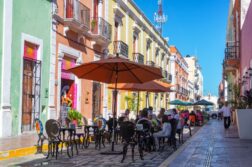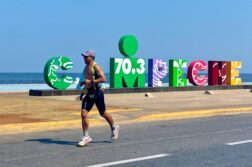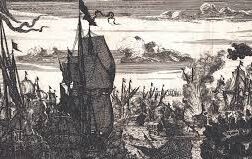Tarpon Town Anglers combines a wonderful year round juvenile tarpon fishery on the “Tarpon Coast” of the western Yucatan with a one-of-a-kind cultural experience in Campeche, Mexico.
Campeche is still dominated by 17th century colonial architecture, and has some of the last genuine marketplaces in Mexico along with great seafood, nearby Mayan ruins, and more. It is a UNESCO world heritage site.
The fishing is as unique as the city. Baby tarpon are nice, but in most adult tarpon destinations you are hoping for one bite per day. Simply size down your tackle when you visit Campeche and plan to jump many, many more tarpon than virtually anywhere else in the world!
Campeche is very famous like the entire mangrove area for the baby tarpon! In these areas there are no big tarpon and people come from all over the world. Just looking for that the «baby tarpon» because the «fight» is completely different and is more fun! And all sport fishermen have been looking for that and they are caretakers just like that, practicing the catch an release to take care of the species as much as possible.
Rodrigo Mora, Campeche Mexico
The old Spanish colonial town of Campeche is located on the western side of the Yucatan Peninsula on the Gulf of Mexico and the Sea of Campeche. With approximately 350,000 inhabitants, Campeche offers a cultural experience unlike any other in the Caribbean angling community. The area is rich in both Mayan and Spanish colonial history, and the city has been named a UNESCO world heritage site. Stunning 17th century architecture, lively markets, incredible hospitality, great seafood, little tourism, nearby Mayan Ruins, and a remarkably clean and safe city make Campeche a delightful place to explore between fishing sessions. Tarpon Town Anglers is owned and operated by Raul Castaneda. Raul is the consummate host who ensures every aspect of your time fishing and experience in Campeche exceeds your expectations.

The fishing features more than eighty miles of mangrove coast with hundreds of creeks and channels. Campeche is exclusively a juvenile tarpon fishery, and is considered on of the world’s most consistent and prolific baby tarpon destinations. There are very few tarpon exceeding 30-40 pounds . . . but lots of juvenile fish! The two main venues are the shore or backcountry mangrove fishing for 5-15 pounders on 7-8 weights, and turtle grass flats (8-12 feet deep) for schools of cruising fish in the 20-40 pound range. The backcountry tarpon fishing is extremely productive and lots of fun with topwater, tons of fish, and good sport on small rods. The turtle grass flats are a bit of a boat run and you need good conditions to pull it off, but this is really a special part of the fishery if it comes together. It is really cool to hop on the boat right in the heart of a busy city built on the waterfront. When you get the right conditions you will get exhausted with catching tarpon.
Raul’s guiding team consists of five native licensed captains who are very familiar with the fishery. Some guides speak better English than others, but they will all put you on fish. Their fleet consists of 21-23’ pangas equipped with new 60-90hp Yahama and Honda 4-strokes. Guides provide flies and leader material for those who don’t want to bring their own. Guides usually fish up to 9-hours per day. Depending on conditions and the time of year, anglers can also split the day. If there is more fish activity during evening hours, guides will fish 4-hours in the morning with the first light and 4-hours in the evening with the last light of the day. Guides will adapt their day to the weather conditions – as weather has a high impact on tarpon behavior.
The Biosphere Reserve of Los Petenes is a vast system of mangrove and wetlands. This environment brings constant streams of freshwater into the Gulf of Mexico, making it the perfect brackish water for baby and juvenile tarpon, snapper, jacks and barracuda. There are many different habitats and fishing scenarios that may play out over the course of a few days with Tarpon Town. All fishing is focused on the mangrove coast that runs northeast from the city’s coastline: mangrove shore, creek mouths, open bays, and deep backcountry mangrove rivers and inlets. The goal is to find rolling, tailing or finning tarpon and find the best approach for sight fishing. Depending on the tide conditions, sometimes you’ll be 100-yards offshore and other times in the middle of a creek – dictating many different scenarios and techniques depending upon the day. If the wind is blowing from traditional trade wind direction of east or southeast, the mangrove shore is always very calm and productive. When the wind changes to west or northwest, the breeze starts rippling the water and that is when sight fishing gets difficult. This usually happens after noon, so more blind casting may be necessary as the day goes on while fishing in open bays.
Campeche tarpon range from to 5 to 30-pounds, averaging 10 pounds, and are typically found in three different scenarios depending upon conditions and the weather:
OFF-SHORE TURTLEGRASS FLATS
Located 2 or 3 miles offshore, casting 50-80 feet, some blind casting needed. With lack of wind, rolling schools can be spotted from 100-yards away. You can expect long fish runs and many jumps.
MANGROVE SHORE
Sneaking around creek mouths and the bay shore casting 20 to 50 feet underneath hanging branches will produce explosive hook ups. Very visual casting.
CREEKS & INLETS
They’ll take you back through the channels where you’ll be casting under a beautiful mangrove canopy. Casting range 10-30 foot with lots of roll casts. As the whole bay bottom is soft and shallow, you’ll be fishing 2 to 8-foot water with no wading.

WHEN TO GO
Campeche is a year round fishery, however there are idiosyncrasies to consider with each season. The late Spring, Summer, and early Autumn provide the most stable weather, however winter months, while a little riskier with cold fronts, can offer most comfortable air temperatures and awesome opportunity on the turtlegrass flats for schooling 20-40 pounders.
Campeche has a tropical climate, like the other three states in the Yucatan Peninsula, and is warm most of the year. Winter temperatures range from 60 to 70F. Late spring and summer months can be very hot! Daytime temps as high as 90-100F with a lot of humidity are the norm. Rainy season starts in early summer with the possibilities of heavy showers during the evening, but are usually coupled with beautiful crystal clear mornings.
NON-ANGLING ACTIVITIES
Fishing is the predominant activity while a guest of Tarpon Town Anglers, however the beautiful city of Campeche is a fantastic town to explore. If you are a history buff, Campeche and the surrounding areas make for a really interesting and educational holiday when not fishing.
HANDICRAFT MARKET
Three blocks from the Ocean View hotel you can shop and take back home part of their traditional artwork pieces of jipi hats, silk and cotton hammocks, wood and bull horn different arts and jewels, local candies and liquors, Mayan shirts and dresses, and much more.
HISTORIC DOWNTOWN
Seven blocks from the Ocean View hotel there used to be a wall that surrounded the city. This is a delightful place to walk around and visit the old style architecture with a Baroque influence. Don’t forget to take pictures of each different style of doors. Every building has a different design. A contrast of colors and lights helps you picture how old Campechanos lived. The cathedral and main square plaza and arc buildings are the most representative sites.
CASA 6 MUSEUM
Across the main plaza an original old lifestyle construction furnished with original designs has been open like a living museum of a rich family lifestyle.
FORTS AND WALL
While touring the city don’t forget to visit the fort and wall that was built to defend the city from pirates. Fortifications built on top of two hills of the city and others on the valley are now Mayan museums and art galleries. The remains of the original old wall still stands south of the historical downtown with a length of more than 100-yds and 20-ft tall. The Land Gate and Sea Gate are the main entrance to the city and are facing each other on 59th street.
MAYAN CITY OF EDZNA
An amazing Mayan city well preserved and restored is a huge part of the Campeche history and culture. It is a short and safe 40-minute ride southbound through the state on well paved roads. There are travel agencies offering transportation services or you can ask their head guide to set up a visit to the site.
SEAFOOD RESTAURANTS
There are various seafood restaurants in town that you cannot miss. Most of them are in downtown area and are a convenient stroll, while others are a bit further and require a taxi. Morgan Cocktails, La Pigua, Chac Pel, Marganzo, Sole, Chez Fernando, Dioniso’s and Langostinos are our suggestions where you can enjoy fresh seafood like fried snapper or pompano, cobia fillet, shrimp salad or dish, octopus, squid, sea snail, stingray, etc.
LAND GATE LIGHT AND SOUND SHOW
Some weekdays and all weekends there is a light and sound show with a 30-minute piracy presentation at night where the history and stories are told under the magic influence of the 40-foot tall Land Gate.
CITY STROLL
An easy way to get a glimpse of the city is to take a one-hour tour on the motor strollers (representing the old railway) and tour the city passing by fortifications, traditional neighborhoods, churches and some other interesting sites.
MALECON
That is the word in Spanish that describes the oceanfront drive. It was built a few years ago and brought a new look to the city. Lighted tracks for jogging or biking and a separate track for a relaxing walk of more than 4-kilometers.
MAYAN CITY OF CALAKMUL
This city was discovered in the early 50s and has been declared as the largest Mayan site in the world. It is in the middle of the Mayan jungle and its main building is taller than any other Mayan structure; including Chichen Itza. Its dimensions are not well appreciated until you are on top of it – where you can see the border of Guatemala and Howler monkeys jumping from the tops of trees. It is the largest biosphere reserve in Latin America after the Amazon and has been designated by UNESCO as a World Heritage Site. It is a long five-hour ride. There are hotels and eco villages to stay, but you can take a camping service from operators in the region and spend a night in the jungle. Please note that you may need an extra day or two to visit the area.





